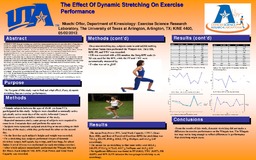| dc.contributor.author | Offor, Nkechi | en_US |
| dc.date.accessioned | 2012-05-31T14:33:45Z | en_US |
| dc.date.available | 2012-05-31T14:33:45Z | en_US |
| dc.date.issued | 2012-05-31 | en_US |
| dc.identifier.uri | http://hdl.handle.net/10106/9762 | en_US |
| dc.description | KINE 4400 | en_US |
| dc.description.abstract | Dynamic stretching uses speed of movement, momentum and active muscular effort to bring about a stretch. It is similar to ballistic stretching except that it avoids bouncing motions and tends to incorporate more sports-specific movements. Researches show that dynamic stretching tends to have more advantages as compared to static stretching (stretching muscles while the body is at rest). Studies show that static stretching techniques do little to increase flexibility or reduce injury when performed before a workout; they also show that static stretches tend to have a detrimental effect on explosive movements and strength output as compared to dynamic stretching. | en_US |
| dc.description.sponsorship | Wilson, Judy, Ph.D. | en_US |
| dc.language.iso | en_US | en_US |
| dc.subject | Peak power | en_US |
| dc.subject | Dynamic stretching | en_US |
| dc.subject | Total work capacity | en_US |
| dc.subject | Heart rate | en_US |
| dc.subject | Rate of perceived exertion | en_US |
| dc.title | The effect of dynamic stretching on exercise performance | en_US |
| dc.type | Presentation | en_US |
| dc.publisher.department | Department of Kinesiology, The University of Texas at Arlington | en_US |
| dc.publisher.department | Exercise Science Research Laboratories, The University of Texas at Arlington. | en_US |

